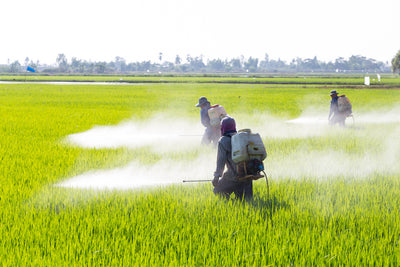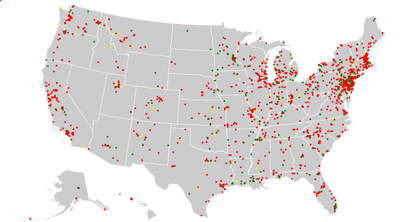Stephanie Angione, Ph.D. | Scientific Contributor
Pesticides are chemicals used to kill environmental pests including insects, weeds, fungi and rodents. These are commonly divided into insecticides (used to specifically target and kill insects) and herbicides (used to kill undesirable plants or “weeds”). The most widely used agricultural pesticides are herbicides, which account for 40% of all pesticide use in the US. In typical agriculture, pesticides are applied to crops in order to provide protection against destructive insects and invasive weeds or fungi. By design, pesticides kill or deter pests and thus are toxic to their intended target organisms. Additionally, many pesticides are toxic to humans, and organochlorine pesticides are 9 of the 12 most toxic organic chemicals, as outlined by the Stockholm Convention in 2001.
Which Pesticides Are Most Commonly Found In US Water Systems?
The most comprehensive information available about pesticide occurrence at the national level is part of a 10-year program by the National Water-Quality Assessment (NAWQA), part of the US Geological Survey (USGS). It provides information about pesticide concentrations in streams and groundwater from data collected between 1991-2001.
Major findings of this study are that pesticides exist in both streams and groundwater throughout the US, in both urban and rural areas, but seldom occur at concentrations that will affect human health. Of the water systems studied, pesticides were found 90% of the time in streams throughout the US in urban and agricultural areas. Groundwater sources were less affected by pesticide contamination, with shallow groundwater sources in agricultural and urban areas having pesticides 61% and 55% of the time respectively.
The most commonly detected pesticides in stream water include five agricultural herbicides, atrazine, metolachlor, cyanazine and acetochlor and five non-agricultural herbicides in urban areas, including simazine, prometon, tebuthiuron, 2,4-D and diuron and three insecticides – diazinon, chlorpyrifos and carbaryl (Figure 1).
Additionally, pesticides detected the most frequently in fish and streambed sediment were organochloride pesticides and degradation products (Figure 2). Organochlorides were used heavily in the 1950s and 1960s and were largely abandoned by the 1980s. However these compounds including DDT are very persistent in soils, sediments and animals, and were thus found at high levels in stream sources.
Despite the widespread existence of pesticides in water systems, levels of pesticides only exceeded human health benchmarks in about 10% of agricultural streams, and 7% of urban streams studied. It should be noted that for public water supply intakes that withdraw water from streams in the US, only 12% are from an agricultural land-use areas, and only 1% from an urban land-use areas. As for groundwater, only 1% of wells sampled had pesticide levels above human health benchmarks.
As for the pesticides present at these excessive concentrations, the most commonly found were atrazine, cyanazine, diazinon and dieldrin. Notably, stream contamination was commonly atrazine and cyanazine and well contamination was dieldrin, which is no longer used but is a known persistent pollutant.
While the compounds discussed above were detected the most frequently in the study period from 1992-2001, pesticide usage changes as new pesticides are developed. A new study of streams sampled in the US in 2015 by the USGS indicates the existence of the relatively new class of pesticides- neonicotinoids, in US water systems. The study found at least one neonicotinoid detected in 53% of all samples, with imidacloprid detected the most frequently (37%). Guidelines on the effects of neonicotinoids in humans and safe levels of exposure have not yet been systematically investigated.
In addition, a 2022 study revealed that very high levels of PFAS were detected in 6 of 10 varieties of pesticides commonly used in rural and agricultural environments.
For more information on tracking of common pollutants and pesticides in drinking water, the USGS has an interactive map to examine levels of pesticides nationwide.
How Is Pesticide Contamination Regulated?
The EPA regulates pesticides nationally under the Federal Insecticide, Fungicide and Rodenticide Act to protect human health and the environment. Aside from the 141 banned and severely restricted pesticides, the EPA has set limits on the allowable amount of pesticides in food and drinking water. Many pesticides including alachlor, atrazine, carbofuran, chlordane, 2,4-D, glyphosate, heptachlor, and simazine are included in the national primary drinking water standards that outline the maximum contaminant level for each compound. Public water suppliers are required to maintain levels below the maximum contaminant level for all compounds listed. The EPA has also established 394 human health benchmarks for pesticides that are registered for use on food crops but are not regulated under the national primary drinking water standards.
How Do I Find Out If My Drinking Water Is Contaminated With Pesticides?
If you are concerned about the effects of pesticides in your drinking water and are served by a public water system, your local water supplier is required to issue a Consumer Confidence Report that lists contaminant levels in the water supply. If you have a private well, a laboratory can test your drinking water.
Although the EPA regulates many pesticides as drinking water contaminants, there are many that are not. Additionally, levels of pesticide contamination can vary widely depending on the agricultural season and pesticides can be used in water systems to control pests like mosquitos.
If you get water from a household well, the local health department should have information about ground water quality and contaminants of concern, but it is often a good idea to have your water tested by a certified laboratory for contaminants. The EPA’s Safe Drinking Water Hotline (800-426-4791) can provide additional resources in your local area. It is also important to consider the proper use of pesticides at home if you have a private well, as pesticide runoff can contribute to well contamination.
How Do I Remove Pesticides From Drinking Water?
A home water filtration system can remove pesticides from drinking water that may not fall under EPA regulation. Water filter systems that use activated carbon as part of the filtration media blend or reverse osmosis can be effective in removing pesticides from water. Contrary to what some people tell you, boiling/freezing water does NOT remove pesticides from drinking water!
Do You Have More Questions About Pesticides In Drinking Water?
At Hydroviv, we make it our business to help you better understand your water. As always, feel free to take advantage of our “help no matter what” approach to technical support! Our Water Nerds will work to answer your questions, even if you have no intention of purchasing one of our water filters. Reach out by dropping us an email (hello@hydroviv.com) or through our live chat. You can also find us on Instagram, Twitter or Facebook!
What Do I Need To Know About Contamination In My Well Water?
Why Should I Care About Endocrine Disruptors?
What Are The Common Problems With Reverse Osmosis Filters?










